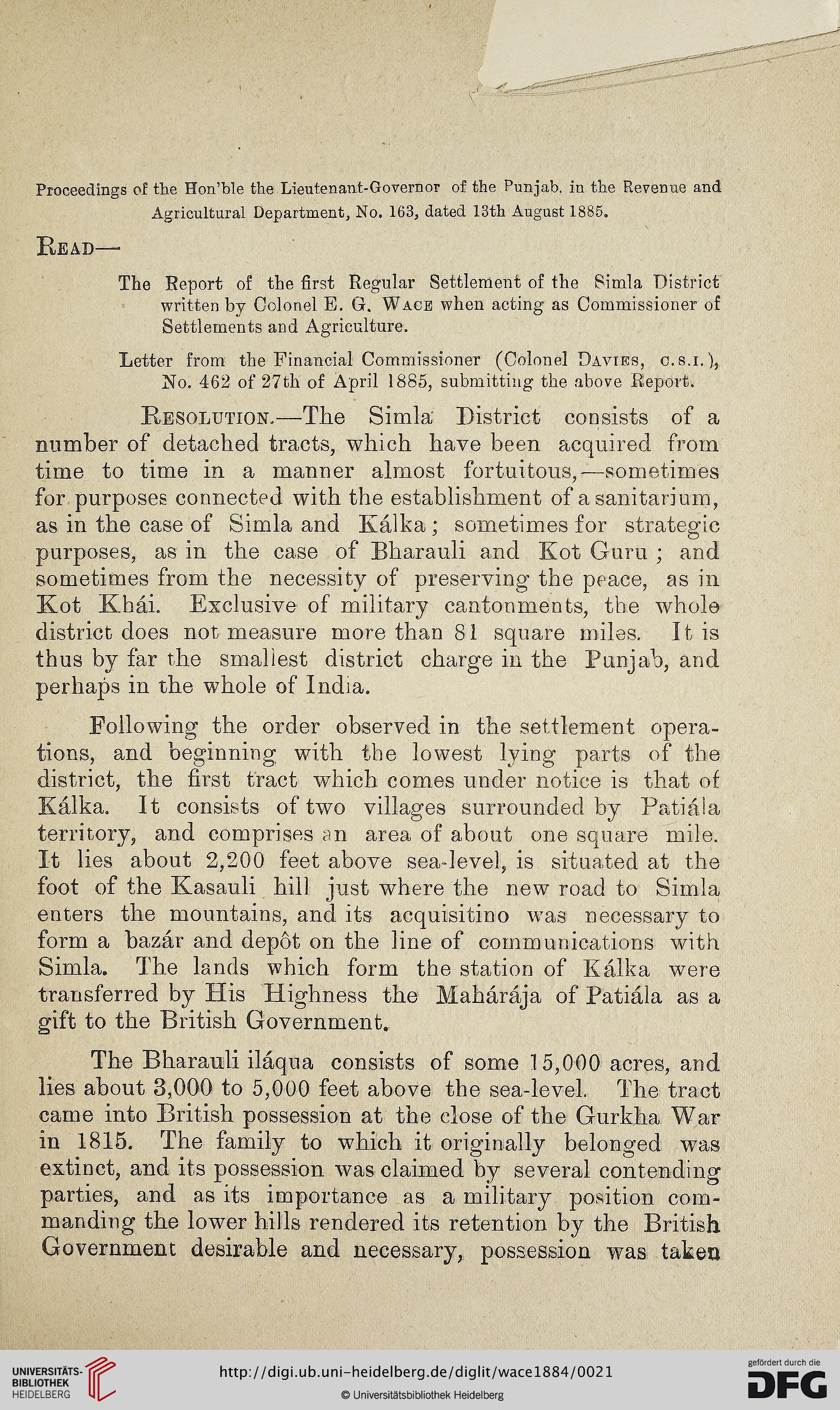Proceedings of the Hon’ble the Lieutenant-Governor of the Punjab, in the Revenue and
Agricultural Department, No. 163, dated 13th August 1885.
Read—-
The Report of the first Regular Settlement of the Simla District
written by Colonel E. G. Wace when acting as Commissioner of
Settlements and Agriculture.
Letter from the Financial Commissioner (Colonel Davies, c.s.i.),
No. 462 of 27th of April 1885, submitting the above Report.
Resolution.—The Simla District consists of a
number of detached tracts, which have been acquired from
time to time in a manner almost fortuitous,—sometimes
for purposes connected with the establishment of a sanitarium,
as in the case of Simla and Kalka; sometimes for strategic
purposes, as in the case of Bharauli and Kot Guru ; and
sometimes from the necessity of preserving the peace, as in
Kot Khai. Exclusive of military cantonments, the whole
district does not measure more than 81 square miles. It is
thus by far the smallest district charge in the Punjab, and
perhaps in the whole of India.
Following the order observed in the settlement opera-
tions, and beginning with the lowest lying parts of the
district, the first tract which comes under notice is that of
Kalka. It consists of two villages surrounded by Patiala
territory, and comprises an area of about one square mile.
It lies about 2,200 feet above sea-level, is situated at the
foot of the Kasauli hill just where the new road to Simla
enters the mountains, and its acquisitino was necessary to
form a bazar and depot on the line of communications with
Simla. The lands which form the station of Kalka were
transferred by His Highness the Maharaja of Patiala as a
gift to the British Government.
The Bharauli ilaqua consists of some 15,000 acres, and
lies about 3,000 to 5,000 feet above the sea-level, The tract
came into British possession at the dose of the Gurkha War
in 1815. The family to which it originally belonged was
extinct, and its possession was claimed by several contending
parties, and as its importance as a military position com-
manding the lower hills rendered its retention by the British
Government desirable and necessary, possession was taken
Agricultural Department, No. 163, dated 13th August 1885.
Read—-
The Report of the first Regular Settlement of the Simla District
written by Colonel E. G. Wace when acting as Commissioner of
Settlements and Agriculture.
Letter from the Financial Commissioner (Colonel Davies, c.s.i.),
No. 462 of 27th of April 1885, submitting the above Report.
Resolution.—The Simla District consists of a
number of detached tracts, which have been acquired from
time to time in a manner almost fortuitous,—sometimes
for purposes connected with the establishment of a sanitarium,
as in the case of Simla and Kalka; sometimes for strategic
purposes, as in the case of Bharauli and Kot Guru ; and
sometimes from the necessity of preserving the peace, as in
Kot Khai. Exclusive of military cantonments, the whole
district does not measure more than 81 square miles. It is
thus by far the smallest district charge in the Punjab, and
perhaps in the whole of India.
Following the order observed in the settlement opera-
tions, and beginning with the lowest lying parts of the
district, the first tract which comes under notice is that of
Kalka. It consists of two villages surrounded by Patiala
territory, and comprises an area of about one square mile.
It lies about 2,200 feet above sea-level, is situated at the
foot of the Kasauli hill just where the new road to Simla
enters the mountains, and its acquisitino was necessary to
form a bazar and depot on the line of communications with
Simla. The lands which form the station of Kalka were
transferred by His Highness the Maharaja of Patiala as a
gift to the British Government.
The Bharauli ilaqua consists of some 15,000 acres, and
lies about 3,000 to 5,000 feet above the sea-level, The tract
came into British possession at the dose of the Gurkha War
in 1815. The family to which it originally belonged was
extinct, and its possession was claimed by several contending
parties, and as its importance as a military position com-
manding the lower hills rendered its retention by the British
Government desirable and necessary, possession was taken




